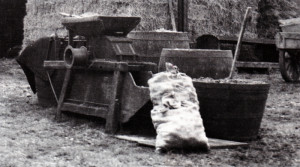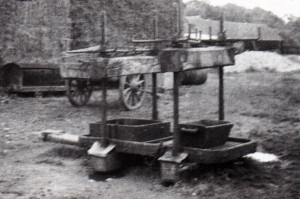
Sweet, medium or dry, that’s what we ask for when we buy. But there wasn’t that choice when dad said: “Well, mother, I’ve bought eight o’ Tom Richard’s pear trees. A tidy crop this time.”
Dad, his rosy face beaming, came into the kitchen and sat down in his high-backed wooden chair. He proceeded to unlace his boots and put on his slippers. When this operation was completed he looked at me, an indulgent smile on his bewhiskered face. “That’s it then, Charlie lad. How about you an’ me starting on ’em tomorrow night?”
Magical words! I loved nothing better than to help dad. Much nicer than playing with my older sisters.
So, on a hazy-gold afternoon in late September I raced home from irksome school lessons, eager to do some real work before mist rose in the valley. A quick cup of tea, a crust of bread and jam, into my oldest clothes and I was ready.
We set off up the road and across Tom Richard’s orchard, armed with a couple of buckets and a quantity of sacks, not forgetting the shaking pole. Dad shook as much fruit off as possible, then climbed up for the rest. My job was to collect the pears in the buckets, then tip them into sacks. It soon grew dark, so we had to have several evenings of it.
When all the fruit was gathered, dad hired a lorry to take it to the nearby cider mill. There we helped by Upping the fruit into a ‘scratcher’ – a contraption that mashed the fruit, operated by a steam engine driving a belt which in turn revolved the drum inside. The fruit came down a chute into a waiting barrel.

A ‘cheese’ was then made, consisting of a dozen squares of sisal. A square box, without top or bottom, was placed on the press, a square of sisal put inside, filled with fruit, and the corners folded towards the centre. The box was then slipped up to the top of the square and two slats inserted to keep it level. Another sisal square was filled, and this operation was repeated, sliding the box up until a dozen squares
had been used and the box removed. The press was then brought to bear on the ‘cheese’, allowing the juice to run into a gully, down a chute and into an oak vat. Half a ton of fruit made approximately 60 gallons of cider or perry.
We had three big barrels -one of 100 gallons and two of 60 gallons each, into which the cider was drawn off. We then went proudly home on the lorry with the barrels bunged and corked. Although 220 gallons might seem a lot, there was very little left when the season came round again. Dad, who worked on the railway, always took a bottle of cider to have with his lunch. And, of course, it was his favourite nightcap. We children loved it too.
He had a special shed down the garden where the barrels were put on their side and the bungs taken out for the cider to ‘work’. Fermentation took about a month, during which time dad topped up the barrels with more cider or water. They were then left for about six months, after which dad removed the corks in the ends and put in the taps. How that first taste of matured cider was eagerly awaited! But sometimes we tried it ‘rough’ before it had properly matured. Ugh! Yet some people like it that way.
There is hardly any private cider-making these days. Most farmers sell their fruit direct to the manufacturers. Occasionally you might come across a cider mill, but a tractor will have
replaced the old steam engine.
Of course there are famous names in the West Country where growers and manufacturers are one and the same. It is a common sight to see acre upon acre of orchards with the name of the owner splashed on hoardings. I have recendy seen such orchards advertising Bulmer’s Cider while driving through Herefordshire.
Although cider-making is now done on a large scale in factories, once the fruit is gathered it goes through much the same process, hydraulic presses being used.
For a perfect cider three varieties of apple should be used in equal quantities – bitter apples for their tannin content, sharp apples for their acid, and sweet apples for their sugar. During fermentation, alcohol is formed from the sugar content and worked by yeast found in the apple skins. When the yeast has absorbed all the sugar it becomes inactive and sinks.
Although we can now buy sweet, medium or dry I still think there is no cider, nor perry, like dad’s. When you’ve had a hand in the making of it, it has a special flavour all its own.
And, as mother used to say: “A drop o’ home-made cider does keep a man home o’ nights.
Charles Daniels








